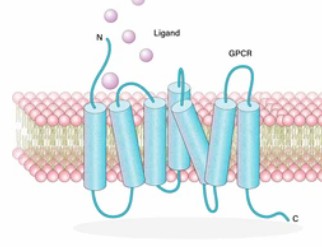GPCRs are widely involved in the regulation of physiological processes. Abnormalities in cellular pathways associated with GPCRs often lead to the development of a range of diseases. Therefore, the study of GPCRs is of great significance for drug development. However, extracting them is a major challenge. Creative Biolabs has built a comprehensive membrane protein platform to provide quality research services for all membrane proteins including GPCRs, such as transporter proteins, kinases, ion channels, and others.

GPCRs are the largest family of membrane proteins in eukaryotes, encoding at least 800 human genes. They contain seven transmembrane domains that regulate important physiological processes through the synergistic action of their signaling pathways. Approximately 50% of currently marketed drugs act on GPCRs, making them important targets for drug development.
GPCRs have a conserved structural feature, namely seven transmembrane helices (7TMs), which form a transmembrane domain that divides the receptor into an extracellular N-terminus, an intracellular C-terminus, three extracellular loops, and three intracellular loops. The extracellular domain of the GPCRs undergoes conformational changes upon binding of agonistic signaling molecules (e.g., odor, hormone, neurotransmitter, chemokine), which in turn triggers the movement of the transmembrane helix, especially the intracellular half of TM6. The intracellular half of TM6 is stretched outward, and the intracellular region of the activated receptor recruits and binds downstream effector proteins (e.g., G proteins, P-arrestin, etc.), which regulate physiological activities in vivo through the cyclic adenosine monophosphate (cAMP) signaling pathway, phosphatidylinositol signaling pathway, and calcium signaling pathway.
GPCRs are associated with many physiological and pathological diseases, including diabetes, obesity, cancer, Alzheimer's disease, and many others. Due to the breadth and importance of GPCRs in the body, they have been important drug targets even before the discovery of ligands. GPCRs have been highly sought after by pharmaceutical companies in recent years, with a total of 1,286 drugs approved by the FDA as of 2016, of which 460 (36%) target GPCRs. Currently, most drugs target class A GPCRs (94%), and because such GPCRs act as receptors for a variety of ligands (e.g., small molecules, peptides, and hormones), this class of GPCRs is the most popular target for drug development.
Although many small molecule drugs targeting GPCRs have entered the market, the current status of GPCR antibody drug development is not promising. One of the main reasons for this is the complex and low abundance of GPCR structures, which makes it difficult to prepare suitable GPCR immunogens. However, with the progress of science and technology, there are now more methods available to overcome these difficulties.
The development of drugs targeting GPCRs faces many challenges, including the limitations of GPCR structural biology and low expression levels. Based on our rich research and study, Creative Biolabs has accumulated a lot of relevant knowledge and experience. We would be glad to discuss with you the research challenges of GPCRs.
All listed services and products are For Research Use Only. Do Not use in any diagnostic or therapeutic applications.